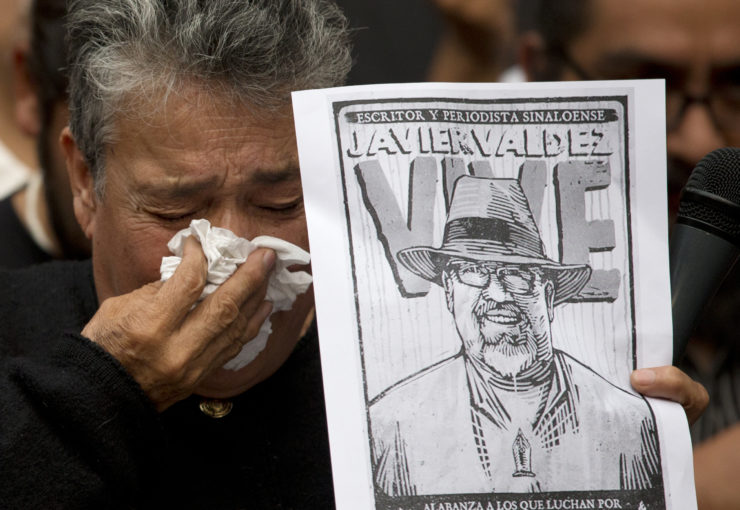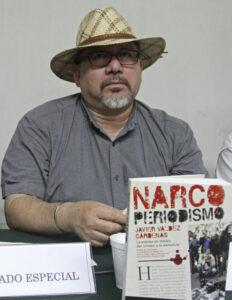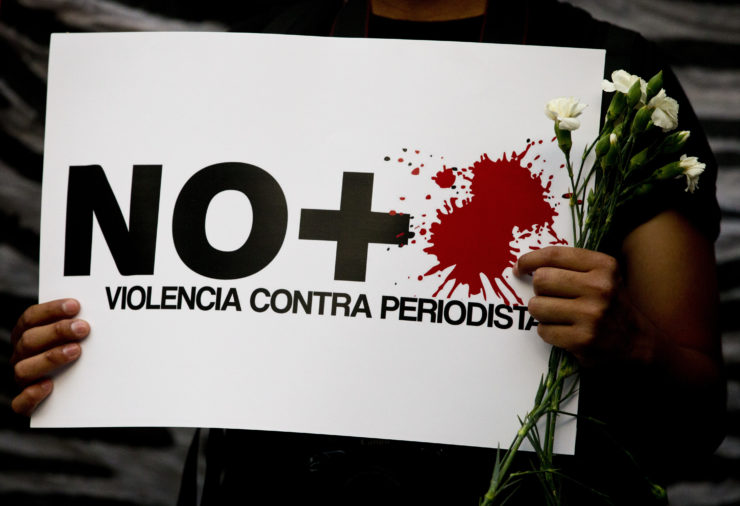Earlier this month, Mexican President President Enrique Peña Nieto met with representatives from the Committee to Protect Journalists and pledged to make the security and protection of journalists a priority.
Eleven days later, Javier Valdez Cárdenas became the sixth journalist killed in Mexico this year. Valdez, a veteran crusading reporter who had long written bravely about the cartels, was shot not far from the offices of Río Doce, the Sinaloa weekly newspaper he cofounded in 2003.
The dangers journalists face in Mexico cannot be overstated: At least 104 journalists have been killed in the country since 2000, and at least 25 remain unaccounted for, the press freedom organization Article 19 says.
"No, we will never be able to tell the full story of that abysmal violence."
Widely known for his weekly column, Malayerba, and books in which he covered the impact of drug trafficking on the Mexican government, media and society, Valdez was the recipient of the CPJ’s International Press Freedom Award in 2011. (Video of his acceptance speech here.) Only last year he received the Maria Moors Cabot International Journalism Prize on behalf of Río Doce.
Valdez’s work for Río Doce and the national daily La Jornada combined elements of investigative and narrative journalism, emphasizing the ethical dimension of journalism and what Valdez saw as the journalist’s responsibility to tell the truth. More important, in his latest book, “Narcoperiodismo,” Valdez wasn’t shy about exploring Mexican journalism’s “contamination” by the narcos.
His journalism told stories that, when put together, reconstructed the horrific jigsaw puzzle of Mexico’s national tragedy.
The following interview by Blanche Petrich with Valdez was published in La Jornada in October. As Mexico celebrates the 100th anniversary of the birth of Juan Rulfo, one of the country’s most gifted storytellers, it has tragic echoes of Rulfo’s classic 1951 short story, “Tell Them Not to Kill Me!”
I translated the interview into English because I think it offers insights into what motivated Valdez and that it's important that English-speaking readers learn more about his life, work and commitment to journalism. I’ve added hyperlinks and supplementary information in brackets.

Culiacán, Sinaloa, Mexico
Journalist Javier Valdez's proposition is that the truth must be told. “Journalists do not like to practice self-criticism, because it’s not easy.” And that is indeed the proposition that Valdez makes in his book “Narcoperiodismo, la prensa en medio del crimen y la denuncia” [“Narco-journalism: The Press in the Midst of Crime and Denouncement”].
Valdez argues that his most recent title, the latest in a list of books that includes “Huérfanos del narco” [“The Orphans of the Narco”], “Los morros del narco,” [“The Children of the Narco”], “Miss Narco” and “Con una granada en la boca” [“A Hand Grenade in the Mouth”], is about “that concern with looking at ourselves face to face, from within. It’s not just about drug trafficking, one of our most ferocious threats. It’s about how the government is harassing the press. [The book is about] how we live in newsrooms infiltrated by the narco, sitting next to a colleague you cannot trust because they may be the one who is leaking reports to the government or the criminals. I also identify the businessmen, media owners and CEOs prioritizing business over stories, who are more concerned with profits than with telling the story of what is happening in Mexico, or about the risks faced by their reporters, their employees.”
"We learned the hard way that it was not enough to merely count the dead. When the violence exploded, reality overwhelmed us. What we wrote, what we published, had no connection with what was happening, that psychosis, that terror."
The name of the multi-award-winning newspaper Río Doce, which he founded along with fellow journalist Ismael Bojórquez and other professionals 13 years ago, owes its name to the 11 rivers in Sinaloa state. A born-and-bred culichi [native and resident of Culiacán, capital city of Sinaloa], Valdez continually crosses the border of that state with its 11 rivers to inquire into the status of the health of journalism in Northern Mexico, from coast to coast.
In his search Valdez discovers terminology used to describe a range of roles, like the panochón, which in underworld lingo means a reporter whom the criminals locate, threaten and then exploit:
“The panochón can become a whistleblower, a journalist who betrays other journalists; the panochón can receive direct phone calls from the boss, receive slaps on the face, back and buttocks; suffer ‘the scissors’ (cutting of limbs), ‘stoves’ (burns) or ‘floor’ (murder).”
Valdez warns us: “The story I tell here is real. It has happened in some places of Mexico, in several cities of different states, at different times.”
Javier Valdez, 49, grew up in the old neighborhood of Rosales, in Culiacán. There his family lived without mixing with “the others,” the still-small community of gomeros who were sulky folk from the Sierra who came down from the mountains carrying opium paste, and ended up settling in the capital of Sinaloa, never integrating with their neighbors. It was the 1970s.
Then other neighbors appeared. They were true villains. Each was a mixture of gunman, policeman and criminal. And some years later others came too: the narcos. That was when that invisible line that divided the common families and the criminals began to falter. "The flirtation began, the culichi society winked at the drug traffickers. The coexistence could no longer be separated; we were already with them. They were already part of our life."
Petrich: To the journalists of this generation in other states who had to cover the violence that was unleashed during President Felipe Calderón’s term, this took them by surprise. Nobody was prepared for this. Unlike you, the Sinaloans...
Valdez: Partly it's true. Culiacán in the 1980s and 1990s was a city where a funeral procession was machine-gunned in the center of town; a city with vendettas between drug gangs. However, when Calderón started his absurd drug war we discovered that no one, not even us in Sinaloa, were prepared to tell the story of this evil. We learned the hard way that it was not enough to merely count the dead. When the violence exploded, reality overwhelmed us. What we wrote, what we published, had no connection with what was happening, that psychosis, that terror. Realizing that we could not cope hit us badly.
Moreover, with each article we published we had to assess the risk. Suddenly, when we were deep into an investigation, someone would come in and tell us to “cool it off.” Sometimes it was a threat; other times it was just people who were worried about us. Either way, we slowed down. In 2009 they threw a grenade at the newsroom; it only caused material damage. We kept asking ourselves: Who did it? Was it the narco, any of the cartels, the Army, the Navy, a hitman, a police chief, a public servant?
Petrich: It is not easy to know if in Sinaloa journalists are better or worse than in other states of the region...
Valdez: It works in our favor to have a single dominant cartel, the Cartel of Sinaloa. There is not much dispute. It is a single group that controls the Government, and gives the orders and also has a monopoly over crime. That leaves some spaces for local journalism, which has no representatives from Sonora, Chihuahua, Nuevo Leon, Tamaulipas or Veracruz, because they are in the middle of a sporadic or constant war between two or three criminal organizations.
In spite of that, we know that we only have a little piece of the monster, a small plot in hell. We tell stories of love in the midst of corpses hanging from the bridges, stories that may even be humorous, like the story of the guy who calls for a dance competition offering millions of pesos and beer as prize to whoever can dance the longest, while at that very same moment in a nearby street, an ice-box appears with five severed heads in it. No, we will never be able to tell the full story of that abysmal violence.

Petrich: Tamaulipas...
Valdez: That was like descending from Culiacán 50 feet into hell. In my book I titled that chapter “Reporting the Silence.” How do you report that? How do these reporters live, what have they done, where did they go, how did they survive, what do they think of those who fled, of those who are no longer with us? What is it like to be trapped in the middle of two or three criminal organizations and end up reporting nothing, publishing photos and images that do not say anything? That is what is published in the Tamaulipas media: nothing. Nothing to do with the street, with how people are suffering.
Petrich: And Veracruz?
Valdez: Veracruz is the amalgamation of all evils. Veracruz is the branch that contains most of the hellish core, where so many journalists have been assassinated, where there have been so many attacks on reporters, who have been harassed by the criminal government of Javier Duarte, where there is so much narcopolitics. Veracruz is of crucial importance, mainly following the murder of [journalist] Rubén Espinosa: the horror, the mourning of journalist colleagues, the denigrating death, the corpses of reporters thrown at the doors of their newsrooms; I had to write about that.
Rubén's story is representative of the violence nationally, because it demonstrates the level of impunity and its impact. No one thought that the arms of the Veracruz monster would reach Mexico City in order to kill a reporter who was alone, impoverished, exposed and vulnerable.”
Petrich: The risks of journalism are multiple and not all come from outside: sensationalism, excessive repetition, normalization of horror ...
Valdez: We all know that. And we've been wrong sometimes. More than being a double-edged sword, journalism is a resource with many blades, many edges. It is necessary to make an effort when telling certain stories so that you do not drool over the material, so that sensationalism does not take over. In journalism you have to make self-criticism and self-review a constant.
Petrich: In “Narco-journalism” you move away from the local chronicle, the testimonial journalism that you have always worked on. In which direction did you take the leap?
Valdez: I want to believe that I was moving toward telling a more public story, seeking to tackle a subject that would allow us to understand ourselves as journalists, full of fear, surrounded by corruption, contaminated by the narcos within our newsrooms. I hope I was able to document this reality, our illnesses, including our pride, dehumanization, impunity, even our poverty, our low wages and working conditions. That's what I tried to do.



